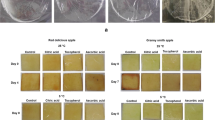Abstract
Objective of this research was to find alternative methods for the control of polyphenol oxidase (PPO) activity in fruits and vegetables with the purpose of reducing or eliminating the use of SO2 for this purpose. Interactions between the use of ascorbic acid, citric acid, EDTA, sodium metabisulphite and heat treatment (70 °C for 2 min) in the control of PPO activity were studied in avocado (var. Fortuna), banana (var. Nanica), apple (var. Ana, Fuji, Gala & Golden), pear (var. D'Agua), peach (var. Real), potato (var. Bintje), eggplant (var. Super F100), mushroom (Agaricus bisporus) and hearts-of-palm (Euterpe edulis Mart.). The results demonstrated that PPO of avocado and eggplant was most resistant to inhibition by the methods used. The least efficient method tested for the control of PPO was the addition of ascorbic acid and EDTA, while the most efficient methods investigated included the use of ascorbic acid, citric acid, sodium metabisulphite and heat treatment. The results indicated that, with the exception of PPO from avocado, the most adequate alternative method to substitute for the use of SO2 in the control of PPO was a combination of ascorbic acid, citric acid and heat treatment.
Similar content being viewed by others
References
Ponting JD (1960) The control of enzymatic browning of fruits. In: Shultz HW (ed), Food enzymes. Westport: The AVI Publ Co, pp 105–124.
Montgomery MW, Petropakis HJ (1980) Inactivation of Bartlett pear polyphenoloxidase with heat in the presence of ascorbic acid. J Food Sci 45: 1090–1991.
Vamos-Vigyazo L (1981) Polyphenoloxidase and peroxidase in fruits and vegetables. CRC Crit Rev Food Sci and Nutr (1): 49–127.
McCord JD, Kilara A (1983) Control of enzymatic browning in processed mushrooms (Agaricus bisporus). J. Food Sci 48: 1479–1483.
Galeazzi MA, Sgarbieri VC (1981) Substrate specificity and inhibitor of polyphenoloxidase (PPO) from a dwarf variety of banana (Musa cavendishii L). J Food Sci 46: 1404–1406.
Silva E, Nogueira JN (1983a) Efeito do calor na atividade da polifenoloxidase e peroxidase em algumas e hortaliças. An ESALQ 40: 137–161.
Bernhardt LM, Lima DC, Yang JF, Soares, GJD (1978). Melhoria das técnicas de processamento de palmito enlatado. ITAL 9: 43–62.
Silva E, Nogueira JN (1983) Efeito do SO2 e do ácido ascórbico na atividade da polifenoloxidase e peroxidase em algumas frutas e hortaliças. An ESALQ 40: 163–180.
Twigg BA, Scott LE, Bounkamp JC (1974) Color of processed sweet potatoes: Effect of additives. J Food Sci 39: 565–567.
Mathew AG, Parpia HAB (1971) Food browning as a polyphenoloxidase reaction. Adv Food Res 19: 75–145.
Sayavedra-Soto LA, Montgomery MW (1986) Inhibition of polyphenoloxidase by sulfite. J Food Sci 51(6): 1531–1533.
Taylor SL, Bush RK, Ebert A (1986) Sulfites in foods. Press Conference Report. Food Technol 9: 48–50.
Ponting JD, Joslyn MA (1948) Ascorbic acid oxidation and browning in apple tissue extracts. Arch Biochem 19: 44–63.
Iaderoza M, Draetta IS, Padula M (1980) Polifenol oxidase de duas cultivares de abacate. ITAL 11: 53–64.
Pintauro ND (1974) Food additives to extend shelf life. London: Noyes Data.
Muneta P, Wang H (1977) Influence of pH and bisulphite on the enzymatic blackening reaction in potatoes. Am Potato J2: 73–81.
Mahoney JA, Graf E (1986) Role of α-tocopherol, ascorbic acid and EDTA as oxidants in models systems. J Food Sci 5: 1293–1296.
Furia TE (1977) Sequestrants in food. In: Furia TE (ed), CRC Handbook of Food Additives. Ohio: CRC Press Inc, pp 271–294.
Author information
Authors and Affiliations
Rights and permissions
About this article
Cite this article
Almeida, M.E.M., Nogueira, J.N. The control of polyphenol oxidase activity in fruits and vegetables. Plant Food Hum Nutr 47, 245–256 (1995). https://doi.org/10.1007/BF01088333
Received:
Accepted:
Issue Date:
DOI: https://doi.org/10.1007/BF01088333




